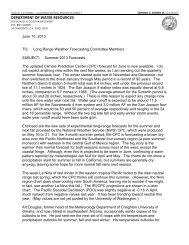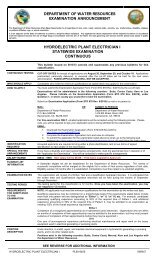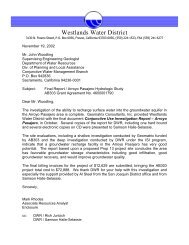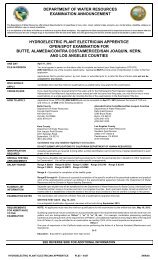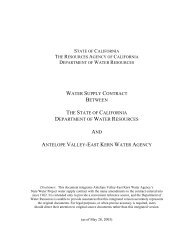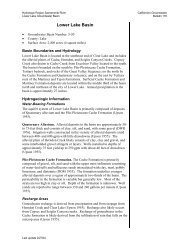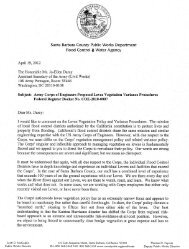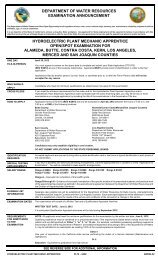Bulletin 1.pdf - California Department of Water Resources - State of ...
Bulletin 1.pdf - California Department of Water Resources - State of ...
Bulletin 1.pdf - California Department of Water Resources - State of ...
Create successful ePaper yourself
Turn your PDF publications into a flip-book with our unique Google optimized e-Paper software.
WATER RESOURCES OF CALIFORNIA 623<br />
records assembled are recent data collected from well drillers by the<br />
Geological Survey and cooperating agencies, but some material was<br />
obtained from publications <strong>of</strong> the Geological Survey, the Oalifornia<br />
Division <strong>of</strong> <strong>Water</strong> <strong>Resources</strong>, and the Oalifornia Division <strong>of</strong> Mines. Of<br />
the 6,000 well logs assembled by the Geological Survey, about 3,600 were<br />
collected by the survey, 2,000 by the Bureau <strong>of</strong> Reclamation, and 400<br />
by the Oalifornia Division <strong>of</strong> <strong>Water</strong> <strong>Resources</strong>. About 4,800 <strong>of</strong> these logs<br />
were located in the field: 3,200 by the Geological Survey, 900 by the<br />
Bureau <strong>of</strong> Reclamation, and 700 by the Oalifornia Division <strong>of</strong> <strong>Water</strong><br />
<strong>Resources</strong> in connection with their investigation in the Sutter-Yuba area.<br />
In the drillers' logs, gravel, sand, clay, and volcanic rocks are usually<br />
distinguished, and the more complete logs mention the color, coarseness,<br />
hardness, degree <strong>of</strong> cementation, and other easily identifiable characteristics<br />
<strong>of</strong> the sediments. In interpreting these logs, it must be remembered<br />
that different drillers attach different meanings to the various terms used<br />
for identifying sediments. •<br />
Peg Model<br />
A peg model <strong>of</strong> the Sacramento Valley, based on drillers' logs, was<br />
constructed to help in recognition <strong>of</strong> hydrologic units and geologic features.<br />
Each well log was represented by a wooden peg a quarter <strong>of</strong> an<br />
inch in diameter, mounted on a base map <strong>of</strong> the valley. A vertical scale<br />
<strong>of</strong> 50 feet to the inch and a horizontal scale <strong>of</strong> 4,000 feet to the inch were<br />
used on the model. Eight major lithologic types were recognized, and<br />
each was distinguished py a different color on the pegs. Three datum<br />
planes, the land-surface altitude as interpolated from topographic sheets,<br />
sea level, and 1,000 feet below sea level, were marked on each peg. Each<br />
peg in its respective location was set in a hole bored in a wooden table so<br />
that the top <strong>of</strong> the table represented 1,000 feet below sea level.<br />
At the scale used for the base map (4,000 feet to the inch) it was<br />
neither practical nor efficient to attempt to utilize all the well logs. Therefore,<br />
in places where wells were closely spaced, it was decided to select<br />
the deeper logs and not to make pegs for logs <strong>of</strong> wells closer to each other<br />
than about 1,500 feet. With this selection, about 3,000 well logs were<br />
utilized in the model. These same logs were used for the estimates <strong>of</strong><br />
specific yield and storage capacity described beyond.<br />
To estimate the storage capacity <strong>of</strong> the valley, it was necessary to<br />
subdivide the near-surface sediments into hydrologic units. The peg model<br />
has been <strong>of</strong> great value in making this subdivision. In addition, much<br />
was learned from the peg model about such geologic information as continuity<br />
<strong>of</strong> sand and gravel strata, depth to bedrock, and the extent and<br />
position <strong>of</strong> volcanic flows and <strong>of</strong> buried gravels <strong>of</strong> ancient stream courses.<br />
Selection <strong>of</strong> Depth Zones<br />
At the request <strong>of</strong> the <strong>California</strong> Division <strong>of</strong> <strong>Water</strong> <strong>Resources</strong>, the<br />
storage capacity <strong>of</strong> the water-bearing deposits <strong>of</strong> the Sacramento Valley<br />
has been estimated for three depth zones: 20 to 50 feet, 50 to 100 feet, and<br />
100 to 200 feet below the land surface. The only exception to this threezone<br />
treatment was for the area south <strong>of</strong> Marysville between the floodplain<br />
deposits <strong>of</strong> the Sacramento River on the west and the channel <strong>of</strong><br />
the 'Feather River on the east. The Oalifornia Division <strong>of</strong> <strong>Water</strong> Reilources<br />
reports that water <strong>of</strong> poor quality exists there at relatively shallow depths<br />
and that it is not generally practicable to draw down the water level to



